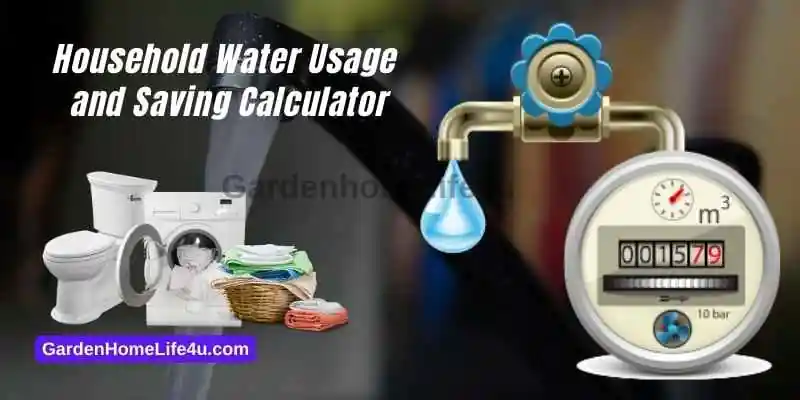Are you looking for ways to make your home more sustainable and eco-friendly? One simple way to achieve this is by reducing your water usage. By conserving water, you not only help the planet but also save money on your utility bills. But how can you know how much water you’re really using? The answer is simple: by using a water-saving calculator. This tool can help you calculate your daily water consumption and identify ways to reduce it. It’s easy to use and can be a game-changer in your journey to a more sustainable home. In this article, we’ll explore how a water-saving calculator works and how you can use it to make a difference. So, let’s dive in and discover how you can calculate your way to a more sustainable home!
Did you ever wonder how much it costs to flush a toilet?
This is a relevant question in today’s environment where inflation is rocketing high and the cost of living is spiraling up day by day.
If your water connection is metered then it might be worth investigating a bit more into your water spending and how much it cost when you use water in everyday household chores. For example, did you know that around 120 toilet flushes will be equivalent to one cubic meter of water which is basically 1000 kg of water, a 1000 KG of water, would be equivalent, in weight, to a small car. Another Example from everyday household chores is the use of, 13 baths would be equivalent to again 1000 kilograms of water which is basically a 1-meter cube. You must be wondering what the fuss is about a 1 m cube. Well, basically this is the unit of Water the water company charges you on, 1 meter cube usage would cost around 3 to 3.5. That would include clean water supply and processing of sewage water as well. It is interesting to note that you are charged for the water supply and processing of the same about of sewage water. That means that water supply and sewerage costs will go hand to hand.
With that basic information in mind, we have developed our simple calculator for you we should help you in understanding and estimate the everyday use of water, and April also certainly help you in saving water and planning your activities in a better way. Please bear in mind that this is only an estimate but we believe that estimate will be fairly close to reality. Obviously, the exact cost of your body uses depends on the supplier and the standing charges.
When you use this calculator bear in mind that most usage is in weeks but the use of toilet flushes is per day because we believe that toilet flashes constitute the major part of your water bill in terms of supply and sewage.
FAQ – Water Cost Saving and Calculator
Why the cost of household water supply has risen?
The cost of household water supply can rise due to several factors. Water utilities may need to invest in new infrastructure, such as water treatment plants, pipes, and pumps, to ensure a reliable and safe water supply. These investments can be expensive and may lead to higher water bills. Drought and water scarcity can cause water utilities to increase the cost of water supply. This is because they may need to invest in alternative water sources or conservation programs to ensure adequate water supply during periods of drought. The cost of energy used to pump and treat water can also affect the cost of water supply. Increases in energy costs, such as fuel or electricity, can lead to higher water bills. Also, Water utilities may need to perform maintenance and repairs on existing infrastructure, which can be costly and may require increased water rates. Not to mention, Regulatory requirements, such as water quality standards and environmental regulations, can increase the cost of water supply. Water utilities may need to invest in new technologies or treatment methods to comply with these requirements, which can increase costs.
Why it is important to save household water and optimize usage?
Saving household water and optimizing its usage is important for several reasons. Water is a finite resource, and its availability can be impacted by climate change and population growth. Conserving water can help ensure its availability for future generations and reduce the strain on natural ecosystems. Treating and delivering water requires energy, which contributes to greenhouse gas emissions and climate change. Conserving water can reduce the amount of energy needed for water treatment and delivery, which can help reduce carbon emissions. Saving water can also help save money on water bills. Moreover, Conserving water can help maintain water quality by reducing the amount of pollution and runoff that enters waterways. Using less water can reduce the amount of wastewater that needs to be treated and discharged into waterways. In last, Water conservation can help ensure a reliable supply of safe drinking water. In areas where water is scarce or where infrastructure is inadequate, conserving water can help ensure that water is available for basic needs, such as drinking and sanitation.
We shall conclude that saving household water and optimizing its usage is an important step towards environmental sustainability, cost savings, and ensuring a reliable supply of safe drinking water.
Which appliances use the most water in the household?
- A standard washing machine uses around 15-45 gallons of water per load, depending on the model and settings.
- A toilet can use around 1.6-6 gallons of water per flush, depending on the age and type of toilet.
- A typical showerhead uses around 2.5 gallons of water per minute, so a 10-minute shower uses 25 gallons of water.
- A standard dishwasher uses around 4-6 gallons of water per cycle, depending on the model and settings.
- Outdoor irrigation systems, such as sprinklers and drip systems, can use a significant amount of water, especially during the summer months.
- Faucets can use up to 2.5 gallons of water per minute, depending on the flow rate and the age of the fixture.
- Reducing the amount of water used by these appliances and fixtures can help reduce overall water usage and save money on water bills.
Is taking regular baths consume a large amount of water?
Yes, taking regular baths can consume a large amount of water, especially if you use a bathtub that holds a lot of water. On average, a bathtub holds about 30-50 gallons of water, depending on the size and depth. If you fill-up the bathtub completely, you can easily use that amount of water for a single bath. In contrast, a 5-minute shower with a low-flow showerhead typically uses around 12-25 gallons of water. To conserve water, it’s a good idea to take shorter showers and use a low-flow showerhead. If you prefer taking a bath, you can try filling the bathtub with less water, taking shallow baths, or taking baths less frequently. Another option is to reuse bathwater for other purposes, such as watering plants or flushing the toilet.

